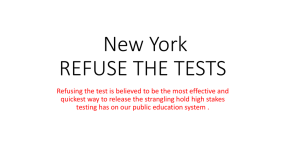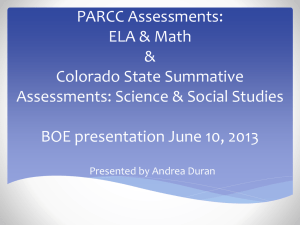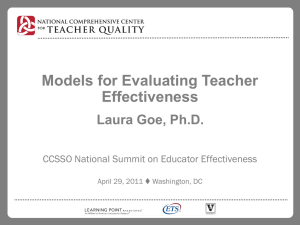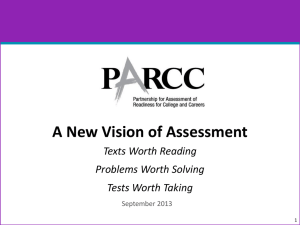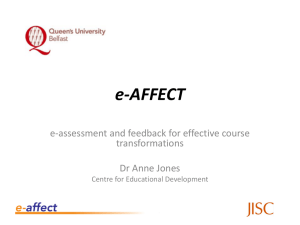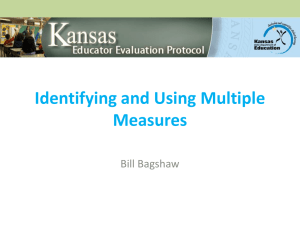21st Century Assessments - Center for Public Education
advertisement
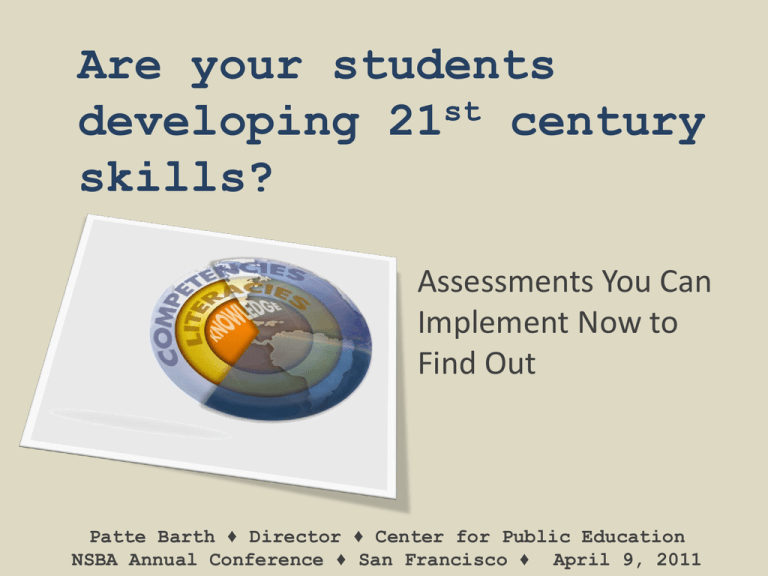
Are your students developing 21st century skills? Assessments You Can Implement Now to Find Out Patte Barth ♦ Director ♦ Center for Public Education NSBA Annual Conference ♦ San Francisco ♦ April 9, 2011 Agenda • • • • • what’s different? a 5-minute primer on testing don’t wait for the state – tests worth teaching to common core state standards & assessments q&a What still works in the 21st century • Post secondary education and training is more important than ever • The traditional college prep curriculum has benefits for work as well as for college • The traditional curriculum is not enough 3 Core curriculum, version 2.0 • Prepares all students for postsecondary education and/or advanced training. • Attends to the application of knowledge and skills • Develops students’ broader competencies related to critical thinking, collaboration, and creativity. 4 Core curriculum, 2.0: Knowledge & skills work together SOURCE: Jerald, Defining a 21 st Century Education, Center for Public Education, 2009 5 Which are most critical skills? The 3 C’s! • Critical thinking and problem solving – Labor economists Levy & Murnane call it “expert thinking” • Communication/Collaboration – Levy and Murnane call it “complex communications” • Creativity -- Knowledge, ability to make connections & creative skills SOURCE: Jerald, Defining a 21 st Century Education, Center for Public Education, 2009 6 Two approaches to assessing high school biology 7 High school biology questions from a state assessment 8 High School Biology Exam When scientists design drugs against infectious agents, the term “designed drug” is often used. A. Explain what is meant by this term. ______________________________________ ______________________________________ ______________________________________ SOURCE: Darling-Hammond, Lessons from Abroad, Edutopia, 2009, exam from Victoria, Australia 9 Biology exam, Parts B & C Scientists aim to develop a drug against a particular virus that infects humans. The virus has a protein coat, and different parts of the coat play different roles in the infective cycle. Some sites assist in the attachment of the virus to a host cell; others are important in the release from a host cell. The structure is represented in the following diagram: The virus reproduces by attaching itself to the surface of a host cell and injecting its DNA into the host cell. The viral DNA then uses the components of host cell to reproduce its parts, and hundreds of new viruses bud off from the host cell. Ultimately, the host cell dies. SOURCE: Darling-Hammond, Lessons from Abroad, Edutopia, 2009, exam from Victoria, Australia 10 B. Design a drug that will be effective against this virus. In your answer, outline the important aspects you would need to consider. Outline how your drug would prevent continuation of the cycle of reproduction of the virus particle. Use diagrams in your answer. SOURCE: Darling-Hammond, Lessons from Abroad, Edutopia, 2009 11 Before a drug is used on humans, it is usually tested on animals. In this case, the virus under investigation also infects mice. C. Design an experiment, using mice, to test the effectiveness of the drug you have designed. SOURCE: Darling-Hammond, Lessons from Abroad, Edutopia, 2009 12 Think about … Which test gets at the 3C’s? How do we know if our students are developing the 3C’s? 13 A 5-minute primer on testing A testing glossary • Standardized test: taken under the same conditions; sometimes at the same time – can be multiple-choice or open-ended (constructed response) • High-stakes tests: consequences attached to the results – eg., state tests for ESEA, student advancement, teacher evaluation • Low-stakes tests: no consequences outside the classroom – eg., interim assessments, teacher tests, course finals SOURCE: A guide to standardized testing, Center for Public Education, 2006 15 A testing glossary • Norm-referenced tests: compare individual students’ achievement to a representative “norm group” – someone will always be above average, and someone will be below average • Criterion-referenced tests: compare individual students’ achievement to an agreed upon criterion, or standard – it’s possible for every student to meet standards, or be “proficient” SOURCE: A guide to standardized testing, Center for Public Education, 2006 16 A testing glossary • Formative assessment: diagnostic, gauges where students are so corrections or interventions can be made – eg., benchmark assessments, classroom quizzes or tests – low stakes attached to performance • Summative assessment: summarizes learning at a point in time – eg., end of course, graduation, state tests – typically higher stakes attached SOURCE: A guide to standardized testing, Center for Public Education, 2006 17 A testing glossary • Validity: the test accurately measures what it intends to measure • Reliability: students taking the test multiple times will receive approximately the same score each time • High stakes tests must meet high psychometric standards for both validity and reliability SOURCE: A guide to standardized testing, Center for Public Education, 2006 18 Test format Multiple-choice • can be standardized & used for high stakes • test taker recognizes answer • machine scorable & cheaper • objectivity less likely to be challenged Performance • can be standardized & used for high stakes • test taker must construct answer • usually scored by hand; more costly • without rigorous scoring processes, can be viewed as subjective 19 The fact that assessments are lower stakes allows them to be of higher quality, both in terms of the range of ways in which learning is to be measured and the performance standards that are set. -- Darling-Hammond & Pecheone SOURCE: Developing an Internally Comparable Balanced Assessment System That Supports High-Quality Learning, Stanford University, 2010 20 How good does your data need to be? Data alert meter Continuous improvement LOW Accountability GUARDED formative: teacher quizzes & tests benchmark assessments ELEVATED middlin’ stakes: district performance assessments & projects HIGH summative: state tests graduation tests SEVERE Don’t wait for the state Tests worth teaching to Good assessment should be indistinguishable from learning. 23 PISA - problem solving in math SOURCE: PISA Released Items – Mathematics, OECD, 2006 24 question Looking at the diagram, the teacher claims that Group B did better than Group A in this test. The students in Group A don’t agree with their teacher. They try to convince the teacher that Group B may not necessarily have done better. Give one mathematical argument, using the graph, that the students in Group A could use. SOURCE: PISA Released Items – Mathematics, OECD, 2006 25 Ohio performance assessment project • pilot project with 15 participating districts • tasks will require students to demonstrate mastery of 21st century skills • assessment will be curriculum-embedded, teacher-managed, rich performance tasks that are both content-focused and skills-driven SOURCE: Beyond Basic Skills, Stanford Center for Opportunity Policy in Education, 2010 26 Think about … Look at the “Heating Degrees” task What content knowledge is required to perform this task? Are 21st c. skills called for (the 3Cs)? How? 27 Project-based assessment • Project-based learning (PBL) is learning through exploration of real-world problems – Typically cross-curricular & collaborative; ends with a culminating project • Culminating projects are sometimes used as end of course assessment or required for graduation – Requires some standardization to assure that common expectations for all students 28 Guiding elements of a culminating project • • • • • • • • • • clear & aligned purpose explicit, rigorous standards student-directed learning & youth engagement clear scaffolding & support of skills authentic project community & parent involvement coordination & comprehensive communication ongoing professional development & program improvement celebration & recognition risk management & liability SOURCE: Project Service Leadership, Developing Civically Rich Culminating Projects, WA, 2005 29 Examples • A senior seminar course culminating in a small group project. Groups design organize, implement, and evaluate a sustainable service project to address a problem or issue. • Practicum in Community Involvement. Students intern with a local nonprofit and produce a project that meets a need with the organization/agency. • Youth Service Center. Students staff a service project resource center that features past projects and helps students design new projects. SOURCE: Project Service Leadership, Developing Civically Rich Culminating Projects, WA, 2005 30 Graduation project – Charlotte-Mecklenburg • 3Ps: Product, portfolio, presentation • Counts as part of the English IV grade at 40% of 4th quarter grade • Intended to reflect work through grades 9 – 12 • Evaluated according to detailed, common scoring guides, or rubrics SOURCE: CMS Graduation Project, www,cms.k12.nc.us retrieved April 4, 2011 31 Project-based assessment pros and cons Pros • model real world activity • integrate knowledge & skills • learning is more relevant • students are more engaged • mentorships strengthen student & school relationships with community Cons • requires considerable staff & student time • finding mentors is challenging • student supervision can be problematic • large-scale attempts have produced mixed student results 32 Coming soon – The common core state standards The Common Core Standards are intended to be: • Aligned with college and work expectations • Focused and coherent • Include rigorous content and application of knowledge through high-order skills • Build upon strengths and lessons of current state standards • Internationally benchmarked so that all students are prepared to succeed in our global economy and society • Based on evidence and research • State led – coordinated by NGA Center and CCSSO SOURCE: Common Core State Standards, www.corestandards.org 34 40 states & DC have adopted the CCSS adopted not adopted 35 PARCC Partnership for Assessment of Readiness for College & Careers • 26-state coalition to develop 21st century assessments aligned to common core standards • headed by Achieve, Inc. • supported with $170 million federal grant • tests will be ready 2014-15 • emphasis on formative, or benchmark assessments to monitor students’ progress toward college/career readiness • assessments will be computer-based 36 26 states & DC are in the PARCC consortium participant non participant 37 SMARTER SMARTER Balanced Assessment Consortium • 30-state coalition to develop computer adaptive tests aligned to common core standards • centered at University of Washington • supported with $176 million federal grant • tests will be ready 2014-15 • emphasis on twice-yearly summative exams • optional formative, or benchmark exams, tools for teachers’ ongoing classroom assessment 38 30 states are in the SMARTER consortium participant non participant 39 45 states & DC are involved involved not involved 40 Points of collaboration SMARTER & PARCC • working to ensure comparability of scores • developing protocols for Artificial Intelligent scoring • working toward same deadlines SOURCE: Center for K-12 Assessment & Performance Management at ETS, webinar April 4, 2011 41 What local districts can do • ask – what do we know about our students’ readiness for 21st century life and work? how do we know it? • engage teachers and your communities in developing 21st century assessment strategies and policies, including what stakes should be attached to results • districts in CCSS states … form study groups to examine the common core standards against current practices 42 What local districts can do • form partnerships with local colleges to develop better assessments, provide professional development and align expectations • start small with project-based assessments; evaluate closely • engage your stakeholders! • get involved with state efforts! 43 Questions? Resources & tools Center for Public Education Objective, easy to understand research Up to date analysis School success stories Data First Data Center with national & state data Learning Center with downloadable videos Ask the expert learn more check out our websites at www.centerforpubliceducation.org and www.data-first.org contact me pbarth@nsba.org

